Viewing: Blog Posts Tagged with: Bees, Most Recent at Top [Help]
Results 1 - 25 of 80
Blog: wonkyworks (Login to Add to MyJacketFlap)
JacketFlap tags: jokes, bees, bee jokes, Add a tag
Blog: OUPblog (Login to Add to MyJacketFlap)
JacketFlap tags: Journals, New York City, bees, Brooklyn, honey, North Carolina, ants, Raleigh, beekeepers, honey bees, *Featured, oxford journals, Science & Medicine, urban farming, Earth & Life Sciences, urban beekeeping, food waste, Clint Penick, journal of urban ecology, local honey, red honey, urban ants, urban bees, urban ecology, Add a tag
The story of New York’s red honey struck a chord with those already concerned about honey bee health. Bees have been hit hard by a host of challenges ranging from parasitic mites to neonicotenoid pesticides—but could red honey be another sign of bee decline? Could artificial flavors and chemicals in human foods be toxic to bees? Could we be at risk if we eat “local honey”?
The post High-fructose honey and the diet of urban bees appeared first on OUPblog.
Blog: OUPblog (Login to Add to MyJacketFlap)
JacketFlap tags: #ESA2016, bee and flower mutualism, cleaner wrasse, cooperation in nature, Judith L. Bronstein, Mutualism, Books, bees, biology, ecology, pollination, cooperation, *Featured, Science & Medicine, Earth & Life Sciences, Ecological Society of America, Add a tag
Birds do it. Bees do it. Microbes do it, and people do it. Throughout nature, organisms cooperate. Humans are undeniably attracted by the idea of cooperation. For thousands of years, we have been seeking explanations for its occurrence in other organisms, often imposing our own motivations and ethics in an effort to explain what we see.
The post Why cooperate? appeared first on OUPblog.
Blog: Playing by the book (Login to Add to MyJacketFlap)
JacketFlap tags: Friendship, Nature, Bees, Gardening, Alison Jay, Sustainability, Wordless books, Add a tag
 A hopeful tale of friendship and flower power, Alison Jay‘s wonderful wordless picture book Bee & Me opens with a young girl startled by a buzzing bee.
A hopeful tale of friendship and flower power, Alison Jay‘s wonderful wordless picture book Bee & Me opens with a young girl startled by a buzzing bee.
No-one likes to be stung and it looks like the bee might be all over before the story’s even begun. Fortunately, a crack in the door of curiosity and bravery opens up the way for an joint adventure bringing plants and flowers across the grey city, delivering beauty and benefits to all city inhabitants, whether honey bees or humans.
Variations on similar theme may be familiar from The Bee Movie, The Curious Garden by Peter Brown or perhaps Big City Bees written by Maggie de Vries and illustrated by Renné Benoit but what Jay brings afresh to this optimistic, reassuring and galvanising story are the glorious details in her beautiful and textured illustrations, often using multiple panels per page, thereby blurring the boundaries between picture book and graphic novel.
Many layers of storytelling run parallel to the main plot. Repeat readings will lead you into the lives of several city inhabitants, when you peer through apartment windows, watching what happens as time passes and the plans of the girl and her bee blossom. It made me think of a recent discussion I had with author Phil Earle, in relation to his fabulous Storey Street series, where he talked about his firm belief that there is story worth hearing behind every door (or in Jay’s case, through every window). A further strand in Jay’s fabric of storytelling follows the growth of friendship between the girl and another young resident in her block of flats, as if distilling how nature can save us from loneliness and make us feel re-connected once more.

Worldwide, bees are in decline. Because of their role as pollinators, we need bees, and bees – facing the threat they now do – need us. This upbeat, optimistic, can-do example of how children are able to make a real and beneficial difference to their world will hopefully inspire a new generation prepared to make a difference.

Enthused by Bee & Me the girls and I set about creating lots of Bee Seed Tape to give away to all our fellow allotmenteers. Seed Tape is a strip of biodegradable material with seeds already imprinted in it, evenly spaced and super easy to use for speedy planting.
First we dyed (organic) toilet paper, spraying it with natural food colouring.

When the paper was dry, we stuck on seeds using a thick flour/water paste (as thick as possible, so that the moisture in it didn’t encourage the seeds to germinate). We chose to use seeds for sunflower and borage because bees love these plants and the seeds are large enough to handle easily.

Once our seed tape was dry we turned it into bees. Our bee body (which was designed to double up as a plant label) was made from a lollipop stick on which the seed types written on it.

The seed tape was wrapped around the lollipop and held in place with some black ribbon to create bee stripes. Ping-pong balls and pipecleaners were used to create bee heads, and instructions for planting the seed tape were stuck onto black cardboard wings (you can download the template here if you’d like to use ours) threaded on to the black ribbon.

Now it was time to share and plant our bee-friendly seeds so off to the allotment we went:

Here’s the seed tape rolled out before we covered it up with soil.

I don’t think I’ve ever seen such fun seed labels before!

A bit of water and now we just need to wait!

Whilst making our Bee Seed Tape we listened to:
Other activities which might work well alongside reading Bee & Me include:
If you liked this post you might like these other posts by me:

If you’d like to receive all my posts from this blog please sign up by popping your email address in the box below:
Delivered by FeedBurner
Disclosure: I was sent a free review copy of this book by the publisher, Old Barn Books.
Blog: Playing by the book (Login to Add to MyJacketFlap)
JacketFlap tags: Bees, Bears, Kindness, Boats, Weasels, Nature play, Celestine and the Hare, Add a tag
Imagine a world where kindness is the order of the day. Where cynicism is put to one side and a simple innocence is instead allowed to blossom into imaginative storytelling. This is the world of Celestine and the Hare, a place full of gentle adventure, generosity and respect for each other and the world around us.

Three uplifting tales of a band of furry friends form the first books from felt artist and début author Karin Celestine. In Small Finds a Home an act of selflessness is the starting point for a lasting friendship. In Paper Boat for Panda, a friend goes the extra mile to make a dream come true, and in Honey for Tea, the friends find an creative way to show their gratitude for something they love.

A spread from ‘Honey for Tea’

A spread from ‘Paper Boat for Panda’
The delicate, finespun storytelling avoids cloying sentiment (helped by a hint or two of mischief occasionally alluded to). The felted friends exude an enormous amount of charm and – if I can coin a word- cuddlability. Echoes of Bagpuss mingle with reminders off the small world play beloved by many children; the use of favourite toys (whether playmobil, lego or plastic animals) and found objects to set up scenes and scenarios is where many children first and most freely experience themselves as storytellers, and Karin Celestine’s wonderful, life-affirming books encourage us all to keep in touch with and to nurture the playfulness, exploration and hope of childhood. These are books that make the world a better place.
The second part of each Celestine and the Hare book features well-explained and amusingly illustrated instructions for a least one craft project related to the story at hand. These invitations to take the story out of the pages of the book and into the living-breathing lives of readers and listeners naturally appealed enormously to all at Playing by the Book Towers. Thus a happy and relaxed day was spent making, sailing and flying boats and bees – a delightful day, the sort I wish all children (and their grown ups) could share.

A spread from the craft activity pages in ‘Paper Boat for Panda’.
Inspired by Paper Boat for Panda we made a flotilla of paper boats and sailed them down a nearby stream.

On some of our boats we wrote poems for the fish and ducks to enjoy!

We didn’t manage to keep our socks dry, but felt all the more like intrepid explorers for that!


As well as setting our boats on the high seas, we made bees out of alder cones and ash keys, inspired by the craft project in Honey for Tea.

A spread from the craft activity pages of ‘Honey for Tea’


My kids are always happy to have an excuse to climb trees, especially if it’s a means to spreading a bit of joy; the sight of these bees amongst the first blossom of spring certainly made us smile.

Whilst we folder our paper boats and made our bees in preparation for launching them all out into the wide world we listened to:
We All Need More Kindness In This World (Guy Davis) from We Banjo 3 on Vimeo.
Other activities which might work well alongside reading these heart-warming stories include:
If you liked this post you might like these other posts by me:

If you’d like to receive all my posts from this blog please sign up by popping your email address in the box below:
Delivered by FeedBurner
Disclosure: I was sent free review copies of these books by their publisher, Graffeg.
Blog: Shelf-employed (Login to Add to MyJacketFlap)
JacketFlap tags: nonfiction, bees, E, STEM, STEM Friday, Add a tag
 Bee Dance by Rick Chrustowski(Henry Holt, 2015)
Bee Dance by Rick Chrustowski(Henry Holt, 2015)
Suitable for sharing with a story time group, Bee Dance is presented as a conversational entreaty to bees,
Waggle faster, honeybee! Buzz louder! Your dance points the way to the prairie."Bee Dance is lyrical nonfiction with large, bright, cut-paper illustrations. An author's note contains additional facts and the author's source material.
- You can watch an actual "waggle dance" below.
- Bee Dance was also reviewed by Archimedes Notebook.
Blog: Kurtis Scaletta (Login to Add to MyJacketFlap)
JacketFlap tags: Miscellaneous, fables, bees, quiroga, lazy bee, Add a tag
 A while back I blogged about an Ursula K. Le Guin story that injects ants with human consciousness and modern human values, and opined that I would like to see a story that didn’t see eusocialism as oppressive — I think we can learn from these little citizens. I have since (while doing immersion tasks on Duolingo) found exactly that story in the form of a fable by author Horacio Quiroga, which seems to be a testament to the responsibilities of an individual to her community above personal will. The ending seems dead serious, but the story seems to have an ironic bent, too, in its didacticism against intelligence (even as cleverness and learning saves the bee heroine).
A while back I blogged about an Ursula K. Le Guin story that injects ants with human consciousness and modern human values, and opined that I would like to see a story that didn’t see eusocialism as oppressive — I think we can learn from these little citizens. I have since (while doing immersion tasks on Duolingo) found exactly that story in the form of a fable by author Horacio Quiroga, which seems to be a testament to the responsibilities of an individual to her community above personal will. The ending seems dead serious, but the story seems to have an ironic bent, too, in its didacticism against intelligence (even as cleverness and learning saves the bee heroine).
This story is closer than the Le Guin, at least, to understanding the eusocial colony of insects. I particularly like the use of “sister” as greeting among bees in the hive, since they would be sisters, as well as carrying the flavor of fellow travelers in the early 20th Century, when the fable was written. I have not read enough Quiroga to know his intent but the era and the location make it more likely that he was sympathetic to socialism, having seen the hell foreign capitalists wrought on his continent.
It seems to be published as a picture book, in both Spanish and English, but minus it’s classic status I seriously doubt any publisher would do a children’s book with such a message against personal exceptionalism and individualism. Unwavering faith in these principles seem to cross all religious and political factions. The fable now would have to take the turn of Lionni’s Frederick, where the other bees come to love the lazy bee for her imaginative flights. For the record, I absolutely love Frederick and can barely read it without tearing up. But sometimes I feel only one side of the story is every told, and that such fables not only prevent us understanding the natural world, but from fully understanding ourselves.
What other fables about ants and bees (or other eusocial organisms) that seem to deal with the role of an individual in a society are out there?
Filed under: Miscellaneous Tagged: bees, fables, lazy bee, quiroga
Blog: Kurtis Scaletta (Login to Add to MyJacketFlap)
JacketFlap tags: plant a pocket of prairie, native grasses and forbs, Miscellaneous, bees, gardening, monarchs, phyllis root, pollinators, Add a tag
I was inspired by one of my own characters to plant a “bee garden,” this spring, and today planted the better part of my wife’s little pocket of prairie with beardtongue, salvia, bee balm, black-eyed susans, coneflowers, thymus, verbena, coreopsis, asclepias, and yarrow. There’s an empty spot for milkweed we’re getting from a neighbor. The stuff in back is prairie grass that’s (mostly) been there for years.
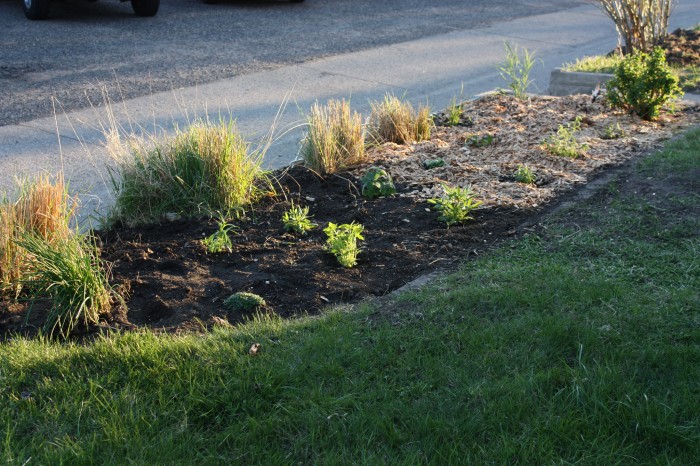
It doesn’t look like much now, but by mid-summer most of these guys will be 2-4 feet high, in bloom, humming with bees and crawling with caterpillars. My wife even supports this venture though she doesn’t like butterflies, but it will be hard not to be taken in by the potential magic of watching, with our bug-loving boy, a monarch nudging its way out of a chrysalis one late summer morning. Thanks to a book by a local author, he is also expecting bison.
Filed under: Miscellaneous Tagged: bees, gardening, monarchs, native grasses and forbs, phyllis root, plant a pocket of prairie, pollinators
Blog: Miss Marple's Musings (Login to Add to MyJacketFlap)
JacketFlap tags: Animals Endangered, Multi Cultural, galapagos george, Edmund Pickle Chin a Donkey Rescue Story, A Grand Old Tree, Marcie Coleen, EARTH DAY 2015, Cathleen Burnham, child activists, Doyli to the Rescue: Saving Baby Monkeys in the Amazon, Life in the Ocean, Parker Pastures, The Last Polar Bear, WAKA, ways to celebrate earth day with kids, Why Are The Ice Caps Melting?, children's books, nonfiction, Inspiration, education, bees, Book recommendation, conservation, Sequoia, deforestation, Earth Day, teacher's guide, endangered species, roots and shoots, animal rescue, Jane Goodall, Compost Stew, Add a tag
Earth Day’s 45th anniversary could be the most exciting year in environmental history. The year in which economic growth and sustainability join hands. It’s our turn to lead. So our world leaders can follow by example. I have very excited … Continue reading
Add a CommentBlog: Jump Into A Book (Login to Add to MyJacketFlap)
JacketFlap tags: Marilyn Scott Waters, Wildflowers, Secret Garden, Valarie Budayr, A Year in the Secret Garden, Nature, bees, Add a tag
Hello and welcome to our Secret Garden! Every Wednesday you can drop by here and find new and special happenings in the Secret Garden. There will be crafts, great food, fun and laughter. So please be sure to come by and see us in our Secret Garden created just for you.
We took a little adventure a couple of days ago and discovered a Secret Garden right in the middle of the forest. We were hiking in the Smoky Mountains, everyone around here knows that the wildflowers bloom over a few weeks and many of us get out to see the forest and mountain sides bloom out in color.
We took a side path and walked ourselves into an ancient moss covered forest. Surrounded completely by mountains we walked deep into the enclosed valley to discover the most enchanted vision I’ve ever seen in nature.
The forest floor was completely covered in blooming phlox, may apples and another little tiny white flower I don’t know the name of. Moss one inch thick covered fallen trees and branches as well as the trunks of living trees.
We were all alone here in this ancient wood. The only sounds were that of a water fall off in the distance, the cacophony of birds and the buzzing of bees.
One of the most important things missing from these photos is the smell. I’ve never smelled anything as this blooming forest. It made us heady with delight. We spent over an hour in this forest soaking it all in. Soon other wildflower enthusiasts joined us and it was nice to meet people who shared in this moment of Secret Garden bliss.
I learned a big lesson on this hike, that a Secret Garden doesn’t have to be behind a wall locked away with a key but can be found in our daily wanderings.
This week I challenge you to find a secret garden near you. It might be behind a wall, it might be under a big tree, it might be in the forest near your home, or behind a log that’s drifted in from the ocean. Wherever it is, go and find it! Cherish those hidden moments in nature’s Secret Gardens!
Have you missed the last few Secret Garden Wednesdays? These are too much fun not to read!
- Secret Garden Wednesday: Building a Bee Watering Hole
- Secret Garden Wednesday: Robin Cake
- Secret Garden Wednesday: Studying the Class of Hunger
- Secret Garden Wednesday: Planting Time
- Secret Garden Wednesday: Book-Inspired FUN
- Secret Garden Wednesday: Perfectly Good Porridge
- Secret Garden Wednesday: Garden in a Jar
- Secret Garden Wednesday: Sticky Toffee Pudding
Want to enjoy more month-by-month activities based on the classic children’s tale, The Secret Garden? A Year in the Secret Garden is over 120 pages, with 150 original color illustrations and 48 activities for your family and friends to enjoy, learn, discover and play with together. A Year In the Secret Garden is our opportunity to introduce new generations of families to the magic of this classic tale in a modern and innovative way that creates special learning and play times outside in nature. This book encourages families to step away from technology and into the kitchen, garden, reading nook and craft room. Learn more, or grab your copy HERE.
The post Secret Garden Wednesday: Wildflowers appeared first on Jump Into A Book.
Add a CommentBlog: Perpetually Adolescent (Login to Add to MyJacketFlap)
JacketFlap tags: Bees, Beekeeping, Fiona Crawford, Book Reviews - Non-Fiction, Urban Beekeeping, Add a tag
Bees in the City: The urban beekeeper’s handbook sold me on both cover design and title. The cover, with its watermarky aesthetics, hints at a modern, professionally designed book that marries content with form (something that’s often missing from beekeeping books, which look like they’ve been run off on a photocopier and patched together in […]
Add a CommentBlog: 4EYESBOOKS (Login to Add to MyJacketFlap)
JacketFlap tags: kidlit, blog, Family, kids, bullying, writing, bloggers, parenting, spring, bees, free, bugs, caterpillar, shoes, giveaway, insects, preschool, book reviewers, illustrated children's books, The Bee Bully, Atlanta author, Caterpillar Shoes, Add a tag
Super excited to announce that our Bee Bully is being featured in Bookbub today and is only $.99 for a limited time. To celebrate we have some free gifts to tell you about. From April 1st – April 5th you can download our latest release, Caterpillar Shoes, absolutely free from Amazon. Check out what’s troubling Patches the caterpillar and the silly decision she makes to live her life to the full. There are some interesting caterpillar facts in the back of this book.
I’ve also got more surprises to share. My friend, Laura Yirak, is also giving away a copy of her delightful bee book, Bumble Babees during this same period.
Scott Gordon has another treat for you. His book, The Most Beautiful Flower will be FREE April 2-April 6. This book is only $.99 on April 1st. Don’t you just love spring! Enjoy these goodies while they last.
Blog: Perpetually Adolescent (Login to Add to MyJacketFlap)
JacketFlap tags: Bees, Beekeeping, Fiona Crawford, Book Reviews - Non-Fiction, Top Bar Beekeeping, Add a tag
It’s B Day, or rather Bee Day! By the time you’re reading this, it will be Bee Day (unless you’re at home reading this on a Friday night, in which case I say more power to you). After a year of reading research, three beekeeping courses (first for native bees, then one each for langstroth-based […]
Add a CommentBlog: Perpetually Adolescent (Login to Add to MyJacketFlap)
JacketFlap tags: Bees, Beekeeping, Book Reviews - Fiction, Fiona Crawford, Add a tag
 During my intervals as a bookseller, there were a few books whose covers really stuck in my mind. The books were consistent sellers with memorable covers, but that I for some reason never quite got round to reading.
During my intervals as a bookseller, there were a few books whose covers really stuck in my mind. The books were consistent sellers with memorable covers, but that I for some reason never quite got round to reading.
Sue Monk Kidd’s The Secret Life of Bees was one such title. Pale yellow—an arguably unusual colour for a book cover in and of itself—with a mix of clearly story-related images, gold-embossed bees, and a title that gave a distinct hint of mystery, it was a book I wanted to if not read, then to know what it was about.
I recalled it during my recent beekeeping courses and subsequent research. Though fiction, I figured it might give me insight into the world of bees and their complex, fascinating, super-organism ways. There were, after all, bees depicted on the cover and mentioned in the title.
The Secret Life of Bees features a young girl named Lily from America’s south who, after an accident as a young child that left her without a mother and with racial tensions coming to the fore when she’s a teenager, finds herself living with three beekeeping sisters.
From Augustine, June, and May (all of whom have month-long celebrations during the months of their namesakes) she learns that the whole world is a bee yard. She also discovers the principle of ‘bee yard etiquette’, including that you should: not be afraid, as no life-loving bee wants to sting you; not swat; wear appropriate, long-sleeved, long-panted clothing; and that if you feel angry, whistle, as anger agitates bees, but whistling calms them.
Monk Kidd (or Kidd—I’m never sure how to shorten tri-part names) has a beautiful way of viewing and expressing the world. She writes of how the bee suit veil softens the world, and how ‘knowing can be a curse on a person’s life. I’d traded a pack of lies for a pack of truth, and I didn’t know which one was heavier’.
The book’s about bees and nature, about truth and lies, about love and sorrow, and race and rights. Each chapter commences with a quote from a non-fiction beekeeping book such as:
If the queen were smarter, she would probably be hopelessly neurotic. As is, she is shy and skittish, possibly because she never leaves the hive, but spends her days confined in darkness, a kind of eternal night, perpetually in labor…He true role is less that of a queen than mother of the hive, a title often accorded to her. And yet, there this is something of a mockery because of her lack of maternal instincts or the ability to care for her young.
The book also weaves in bee history and trivia, such as how beekeepers used to drape material over their hives when there was a death in the family. It was to prevent the bees leaving, as having bees around was supposed to ensure a dead person would live again. The accompanying adage is : ‘When a bee flies, a soul will rise’. Interestingly, honey is a preservative—people used to use it to embalm bodies.
The Secret Life of Bees doesn’t include as much bee information as I’d hoped, but the story itself drew me in after an initial slow start. Each time I thought I should put the book aside for a more fact-based read, I found myself wondering what would happen to Lily and the sisters she encounters, what happened with her mother all those years ago, and whether there’d be a happy ending with her first love.
Now that I know the story, the cover befits the tale and was worth finally cracking the spine. It also inspires me to revisit a few of the other titles that caught my attention during my bookselling stints.
Add a CommentBlog: Perpetually Adolescent (Login to Add to MyJacketFlap)
JacketFlap tags: Bees, Beekeeping, Fiona Crawford, Book Reviews - Non-Fiction, Urban Beekeeping, Add a tag
 Anyone who follows my social media feeds (or this blog, as I’ve written about it here) would be aware I’ve been learning beekeeping. It’s an admittedly strange thing for a vegan to be doing, but my reasons are not honey-related, but purely environmental—I’m deeply concerned about bees’ and the environment’s health and feel we’re not doing nearly enough to care for either.
Anyone who follows my social media feeds (or this blog, as I’ve written about it here) would be aware I’ve been learning beekeeping. It’s an admittedly strange thing for a vegan to be doing, but my reasons are not honey-related, but purely environmental—I’m deeply concerned about bees’ and the environment’s health and feel we’re not doing nearly enough to care for either.
My experience to date has, however, involved not finding a lot of accessibly designed and delivered information. At risk of typecasting all beekeepers and offending roughly most of them, I’ve found beekeeping to be the realm of wily 60-year-old men whose tacit knowledge is exceptional, but whose books (read: mostly pamphlets) about the matter are either non-existent or leave plenty to be desired.
And the beekeepers and their publications are commercially focused, honey-obtaining obsessed, and predicated on you having a lot of hives on a lot of land in rural areas. I’ve located little in the way of good resources for environmental-concerns-driven urban beekeepers, much less for women (of which I happen to be one). And certainly not in an Australian setting (the best I’ve found so far has been New York urban beekeeper Megan Paska’s The Rooftop Beekeeper, which features beekeeping in an urban environment and is by a woman).
Clearly, then, I was enthusiastically excited when Murdoch books sent me advance notice of (and an opportunity to review) a forthcoming bee-themed title.
Backyard Bees a guide for the beginner beekeeper brings together Murdoch’s strong aesthetics and communication design with the no-nonsense practical beekeeping explanations of a modern urban beekeeper.
With stellar images of the ilk we’ve come to know and love from Murdoch’s cookbooks meet coffee table porn married with author and ‘beevangelist’ Doug Purdie’s pragmatic, written-from-experience instructions, the handily sized Backyard Bees is timely and solid.
Purdie, who co-operates urban beekeeping business The Urban Beehive, got interested in bees for similar reasons to me: He became aware of how integral they are to the world, and was alarmed at how greatly they were in trouble and how little we were doing to ensure their (and our own) survival.
He too found his local beekeepers to be wise older gentlemen, but that the beekeeping secrets seemed in danger of being lost on future generations. So he got involved, both by writing this book, but also starting his own urban beekeeping business and the Sydney City branch of the NSW Amateur Beekeeping Association. That is, both operating in the city and catering for inner-city dwellers such as me, who are keen to do as much as they can, but who have small-yard and close-neighbour considerations.
Purdie delivers a trove of useful facts, including that despite some people’s fears, penicillin is a higher cause of death than are bee stings, and that in Greek mythology, a swarm landing somewhere was considered not a threat, but a great blessing.
Purdie and Murdoch (props to the editor and designer involved) lay out the book and the information you need to get started in concise, chronological order. They complement them with rich images that make you want to race out, don a bee suit, and get ‘keeping.
Perhaps my favourite part, though, is that Purdie features a bunch of beekeepers of varying backgrounds, including women (one of my greatest frustrations has been trying to find other women beekeepers; one of my greatest fears is that I won’t physically be able to manage the hives, which can get rather heavy once they’re full of bees and honey).
 There’s Mat and Vanessa, from Melbourne City Rooftop Honey (AKA the guys who kind of pioneered modern urban beekeeping in Australia, or at least popularised it).
There’s Mat and Vanessa, from Melbourne City Rooftop Honey (AKA the guys who kind of pioneered modern urban beekeeping in Australia, or at least popularised it).
There’s horticulturalist Elke, who found it took a few attempts to get the bees to accept her (I’m nervous about my beginner-ness and how steep my learning and succeeding curve will be, so it’s fantastic to know not everyone immediately takes to beekeeping like metaphorical ducks to water).
There’s Katrina and Jonathan, who keep their hive in their chicken pen, as chickens are bees live in great symbiosis. Chickens are disinterested in eating bees, but extremely interested in gobbling up the beetles that like to invade hives (if you follow my social media, you’ll know I adopt former battery hens under the long-running Operation Chooken campaign, so this is of significant interest and relevance to me).
And there’s George and Charis, Swiss husband and wife and beekeeping veterans, who make beekeeping (and life) look like a fantastically fun adventure.
Helpfully rounding out the book is a glossary of terms, an index, and a bunch of honey-themed recipes replete with salivation-inspiring images.
Backyard Bees will be released in August, just in time for people to read the book, seek out beekeeping courses, and prep to commence beekeeping in early spring. I’d recommend it for a touch of inspiration combined with practical advice—I know I’ll be referring to it regularly when my bees arrive in September and I attempt to put beekeeping theory into practice.
Add a CommentBlog: The Children's Book Review (Login to Add to MyJacketFlap)
JacketFlap tags: Bees, Author Showcase, Jim Wohlbach, Josh Wohlbach, Add a tag
In “The Bees Are Gone” author Jim Wohlbach explains the collapse of the bee population and the consequences that the disappearance of the bees will have on our existence.
Add a CommentBlog: the dust of everyday life (Login to Add to MyJacketFlap)
JacketFlap tags: watering, flower pots, summer patterns, summertime illustration, tomato illustrations, FLOWERS, bees, Garden, bunnies, Add a tag
This is an illustration as a promotional piece. I love patterns, and flowers. I am excited for the people in the nice summer areas, ours are hot here in Florida. So, enjoy your summer.
Blog: RabbleBoy (Login to Add to MyJacketFlap)
JacketFlap tags: picture book, Bees, Bears, children's picture book, racing, Void, grand prix, Kip Noschese, scbwi, Add a tag
Otto is a bear with a unique talent for racing cars. It’s a talent that requires drivers to be fearless. Otto has only one fear. A great fear — BEES! When he crosses paths with some very smart bees that love racing as much as he does, he might need to overcome his fear if he wants to win.
About the Author
Kip Noschese is originally from Pittsburgh, Pennsylvania. He has designed backgrounds for many award winning animated television shows, including Wild Thornberrys, Rugrats and Family Guy. Otto & the Grand Prix Bees (2013) is his debut children’s book. He currently resides in Henderson, Nevada. kipnoschese.com
Get this on Amazon Otto & the Grand Prix Bees
Blog: The Children's Book Review (Login to Add to MyJacketFlap)
JacketFlap tags: Ages 0-3, Ages 4-8, Ages 9-12, Picture Books, Book Lists, Oliver Jeffers, Spring, Bees, The New York Times, Best Sellers, Picture Books For Children, Tom Lichtenheld, Svein Nyhus, Brian Floca, Eric Litwin, Sherri Duskey Rinker, Best Kids Stories, Drew Daywalt, Charles Micucci, Christian Løchstøer, Ylvis, Add a tag
Spring is here, the season of regeneration that brings plenty of flowers with nectar which worker bees gather and convert into honey. The Children's Book Review's best selling picture book for this month is full of information on the wonderful and very much under-appreciated honeybees, The Life and Times of the Honeybee by Charles Micucci.
Add a CommentBlog: Perpetually Adolescent (Login to Add to MyJacketFlap)
JacketFlap tags: Fiona Crawford, Book Reviews - Non-Fiction, Operation Honey Bee, Rooftop Beekeeping, Urban Beekeeping, Bees, Beekeeping, Add a tag
 The average age of a beekeeper is circa 60 years old. So, as a Gen Y female, I don’t exactly fit the beekeeper mould. It also explains—forgive me for insulting just about every beekeeper out there—why I’ve had trouble finding beekeeping books tailored to my tastes and needs.
The average age of a beekeeper is circa 60 years old. So, as a Gen Y female, I don’t exactly fit the beekeeper mould. It also explains—forgive me for insulting just about every beekeeper out there—why I’ve had trouble finding beekeeping books tailored to my tastes and needs.
Much of the beekeeping knowledge is, it seems, tacit. Think wily, hardy guys who’ve been tending paddock-loads of bees in rural areas. Not young, urban, emerging professionals looking after a hive or two in their backyards.
Complicating the matter is that any publications out there are fact- rather than design-led. That is, they’re helpful-ish, but they’re about as much fun as reading a textbook. Facts are integral to successful hive health and beekeeping, no doubt, but if they’re not delivered in a way you can understand or apply them, they’re pretty much useless.
Needless to say, I was stoked to find out a book was about to be published by a Gen Y-ish female urban beekeeper in New York. I pre-ordered Megan Paska‘s The Rooftop Beekeper and tried to temper my impatient enthusiasm. It might not be exactly what you’re looking for, I kept telling myself. You’re probably not going to get all the answers you’re after from it, I said.
I did a bit of a H&R Block-style fist pump when the book arrived in the mail, though. Beekeeping for beginners delivered in accessible terms? Check. A book written by someone like me for someone like me, i.e. a time-poor, inner-city Gen Y keen to do their bit for bees and the environment, but unsure how or where to start and not able to make it a full-time gig? Check. A book that understands the importance of marrying design with content in order to enhance its effect? Check.
Paska is a New York native who spent her childhood holidays visiting her relatives’ Virginia-based farm. That foundation led to a hankering as an adult to grow her own vegies at her New York home, where Paska gradually began expanding her efforts and her repertoire. Patches of tomatoes and herbs came to incorporate okra, lettuce, squash, capsicum.
The love and infectiousness of nurturing vegetables in turn acted as a natural progression slash gateway drug to Paska adding bees to the mix—those vegies needed help growing and bees were just the critters to facilitate that.
Her beekeeping practice is especially surprising when you consider her opening chapter (entitled How a City Girl Got Stung) explains she became an urban apiarist under the most unlikely of circumstances. That’s not simply because she keeps bees in one of the most densely populated, seemingly least-bee-friendly cities on earth (New York City), but because she’d spent most of her life being afraid of bees. Nay, terrified of bees.
But, ‘as a garden-obsessed adult’, she realised bees were far from vicious and were instead incredible creatures going about their incredibly important job of pollinating. She set about learning about them, learning the art of caring for them, and getting involved in such projects as the Brooklyn Grange rooftop garden (if you haven’t looked it up, I suggest you do so now).
Moreover, Paska is encouraging. Her book makes me feel as though I can manage the job (even if I will need the occasional little bit of help with the heavy lifting).
‘It’s my hope that as you read this book—learning about bee anatomy, colony management, or honey collection—you’ll grow confident enough to plan your own urban apiary,’ Paska writes:
Be fearless; simply do it. This book is meant to be a primer for making it happen. In fact, it follows my own decades-long path to becoming a beekeeper—from daydreaming to reading to doing. So get ready to score yourself a smoker, a veil, and a hive tool—and, even more important, your very own honeybees. Just be prepared; you might fall in love with being a beekeeper when you least expect it.
We’re seeing a surge in interest in beekeeping, with people like you and me (read: non-traditional, part-time beekeepers) being acutely aware of our effects on the food chain and wanting to right some of humans’ food-chain wrongs. So yes, we’re seeing some people unexpectedly falling in love with beekeeping.
Which is just as well—this might mean we start to see a reversal of some of the crazy, cruel, and inefficient schemes currently occurring. Sixty per cent of bee hives in America are shipped cross-country on the backs of trucks as beekeepers try to pollinate produce.
Should we talk about the inefficiencies and the fossil fuels burnt to facilitate this practice? Or the genuine—and genuinely-puzzling-to-me—surprise said beekeepers and the wider population seem to express when stressed bee colonies, not designed to be moved in such ways, are collapsing?
Paska’s book is concise, clear, and pragmatic. It’s clearly written by someone who still remembers what it’s like to get started, and to be starting in an urban environment with such considerations as roof access and communicating your beekeeping practices to close-by neighbours whose perceptions of bees might not be entirely positive.
And it entails beautiful a layout and images that make beekeeping seem achievable and enjoyable. (The back cover blurb describes the book as ‘part essential guide to urban beekeeping, part love song to the amazing honeybee, with more than 75 photographs and illustrations’.) Which is exactly the kind of book I’ve been looking for—part bed-time read, part reference book, part guide, part memoir.
If you’re thinking, as I am, of getting in to beekeeping (I’ve just completed a hive-building course an am about to embark on some mentoring, with bees set to arrive in spring Australian season-wise), I’d suggest The Rooftop Beekeeper is a good starter. Brand new, with an urban and hobby focus, and with all the basics covered, it’s likely to prove a good stepping stone in to some more serious bee-loving commitment.
Add a CommentBlog: OUPblog (Login to Add to MyJacketFlap)
JacketFlap tags: flowers, Journals, bees, biology, ecology, pollen, biodiversity, bumblebee, bumblebees, Editor's Picks, *Featured, oxford journals, Science & Medicine, Earth & Life Sciences, annals of botany, english gardens, michael hanley, palaearctic, by victorllee, Add a tag
By Michael Hanley
Urban gardens are increasingly recognised for their potential to maintain or even enhance biodiversity. In particular the presence of large densities and varieties of flowering plants is thought to support a number of pollinating insects whose range and abundance has declined as a consequence of agricultural intensification and habitat loss. However, many of our garden plants are not native to Britain or even Europe, and the value of non-native flowers to local pollinators is widely disputed.
We tested the hypothesis that bumblebees foraging in urban gardens preferentially visited plants species with which they share a common biogeography (i.e. the plants evolved in the same regions as the bees that visit them). We did this by conducting summer-long surveys of bumblebee visitation to flowers seen in front gardens along a typical Plymouth street, dividing plants into species that naturally co-occur with British bees (a range extending across Europe, north Africa, and northern Asia – collectively called the Palaearctic by biologists), those that co-occur with bumblebees in other regions such as southern Asia, and North and South America (Sympatric), and plants from regions (Southern Africa and Australasia) where bumblebees are not naturally found (Allopatric).
Rather than discriminating between Palaearctic-native and non-native garden plants when taken together, bees simply visited in proportion to flower availability. Indeed, of the six most commonly visited garden plants, only one Foxglove (Digitalis purpurea – 6% of all bee visits) was a British native and only three garden plants were of Palaearctic origin (including the most frequently visited species Campanula poscharskyana (20.6% of visits) which comes from the Balkans). The remaining ‘most visited’ garden plants were from North America (Ceanothus 11% of visits) and Asia (Deutzia Spp 7% of visits), while the second most visited plant, Hebe × francisciana (18% of visits) is a hybrid variety with parents from New Zealand (H. speciosa) and South America (H. elliptica).
However a slightly different pattern emerges when we consider the behaviour of individual bumblebee species. This is important because we know from work done in natural grassland ecosystems that different bumblebees vary greatly in their preference for native plant species. Some bumblebees visit almost any flower, while others seem to have strict preferences for certain plants. The latter group (‘dietary specialists’) include bees with long tongues that allow them to access the deep flowers of plants belonging to the pea and mint families that short-tongued bees cannot. One of these dietary specialists, the aptly named ‘garden bumblebee’ (Bombus hortorum), showed a strong preference for Palaearctic-origin garden plant species (78% of flower visits by this species); although we also saw this species feeding on the New Zealand-native, Cordyline australis. Even more interesting was the fact that our most common species the ‘buff-tailed bumblebee’ (B. terrestris) appeared to favour non-Palaearctic garden plants (70% of all visits) over garden plants with which it shares a common evolutionary heritage (i.e. Palaearctic plants). So it seems that any preference for plants from ‘home turf’ varies between different bumblebees; just like in natural grasslands, some bees are fussy about where they forage, and others not.
So what should gardeners do to encourage pollinators? Our results suggest that it is not simply a question of growing native species even if this is desirable for other reasons, but that any ‘showily-flowered’ plant is likely to offer some forage reward. There are caveats, however. Garden plants that have been subject to modification to produce ‘double’ flowers that replace or obscure the anthers and carpels that yield pollen and nectar (e.g. Petunias, Begonias, and Hybrid Tea roses) are known to offer little or no pollinator reward. A spring to autumn supply of flowers of different corolla lengths is important to provide both long- and short-tongued bumblebees with nectar. A reliable pollen supply is particularly important during nest founding through to the release of queen and male bees at the end of the nest cycle. Roses and poppies are obvious choices, but early season willows also offer pollen for nest-founding queens. Potentially most crucial of all however, are the pea family as they offer higher quality pollen vital for the success of the short-nest cycle, specialist bumblebees such as B. hortorum. It is also important that access to what gardeners refer to as ‘weeds’ is available. Where possible gardeners can set aside a small area to allow native brambles, vetches, dead nettles, and clovers to grow, but as long as some native weed species are available in nearby allotments, parks, or other green spaces, we suggest that a combination of commonly-grown garden plants will help support our urban bumblebees for future generations.
Dr Michael Hanley is Lecturer in Terrestrial Ecology at the University of Plymouth. He is co-author of the article ‘Going native? Flower use by bumblebees in English urban gardens’, which is published in the Annals of Botany.
Annals of Botany is an international plant science journal that publishes novel and substantial research papers in all areas of plant science, along with reviews and shorter Botanical Briefings about topical issues. Each issue also features a round-up of plant-based items from the world’s media – ‘Plant Cuttings’.
Subscribe to the OUPblog via email or RSS.
Subscribe to only earth, environmental, and life sciences articles on the OUPblog via email or RSS.
Image credit: Bumblebee on apple tree. By Victorllee [CC-BY-SA-3.0], via Wikimedia Commons
The post Bumblebees in English gardens appeared first on OUPblog.
Blog: Perpetually Adolescent (Login to Add to MyJacketFlap)
JacketFlap tags: Bees, Beekeeping, Fiona Crawford, Book Reviews - Non-Fiction, Add a tag
 There’s a second, complementary element to Operation Chooken, which I blogged about yesterday. Entitled Operation Honey Bee (are you sensing a theme?), I’m about to learn beekeeping. For environmental reasons.
There’s a second, complementary element to Operation Chooken, which I blogged about yesterday. Entitled Operation Honey Bee (are you sensing a theme?), I’m about to learn beekeeping. For environmental reasons.
Bees are in trouble worldwide. Pesticides and mites are wiping them out at frightening rates, and what few humans seem to truly grasp that if the bees go, we go. That’s because bees pollinate a plethora of food and the entire ecosystem and our foodchain relies on them. (Apparently in China people are being paid to walk around and attempt to manually pollinate fruit trees. Talk about inefficient, ineffective, and downright terrifying that it should even need to be done.)
And in case you’re wondering how bees and chookens (the technical term for ‘chickens’) fit together, the answer is extremely well. It turns out the chookens ignore the bees and both potter about and do their own things, except the chookens eat any critters that tend to want to invade the bee hives. I reckon that’s pretty much perfect symbiosis—some people even keep the hives inside their chooken pens, although I can’t say I’ll be doing that (mostly for space reasons).
Right now, I’m on the lookout for good beekeeping books, both those that detail the how-tos of beekeeping in accessible and interesting terms and those that document the experience of being a beginner beekeeper trying to find your way.
I’m also madly trying to cram in and retain bee stats and beekeeping info. For instance, there can be some 60,000 bees in a hive, including just one queen. Most of the bees are female and they’re called worker bees because they do all the cleaning, baby bee raising, and so on. Also, bees maintain a hive temperature of 32–35 degrees all year round, regardless of where they are in the world. As a cold frog, I can wholly appreciate that last fact.
Truthfully, it’s been tricky to try to find an interesting and informative beekeeping book. I’m probably going to offend the world’s beekeepers here, but the books tend to be amateur, black-and-white, photocopy-equivalent copy that’s dry and in no way inspiring. So I’ve been looking more broadly, trying to find both a memoir and a modern version of beekeeping.
The first book of that ilk off the rank has been From A To Bee, a memoir of James Dearsley’s first year as a beginner beekeeper. It’s a great title for a book—he crowdsourced it via social media—and I’d hoped the book would give me insight into what I’m about to encounter.
In a lot of ways it has, but it hasn’t quite been as good as I’d hoped. My main gripe is that it reads as a blog plonked directly into print. Which it essentially is. Print books are not the same as blogs and vice versa, and the content needs to be tailored accordingly. Also, why buy the book when you can read the entries online for free?
Not helping the matter is that Dearsley’s motivations are completely opposite to mine: He’s obsessed with obtaining a single jar of honey in his first year of beekeeping; I’m vegan and see beekeeping only as an environmental and bee-survival mechanism. (I’m amazed at the number of people who are genuinely surprised to discover that honey isn’t an excess product bees produce; it’s actually their food and we steal it, substituting it with sub-standard sugary water.)
 Suffice to say, I found his obsession with obtaining honey at all costs, which included moving a hive to another location to try to increase pollen collection and with no thought to the stress it would put on the bees or that it might not be in their interest, more than a little selfish and offputting.
Suffice to say, I found his obsession with obtaining honey at all costs, which included moving a hive to another location to try to increase pollen collection and with no thought to the stress it would put on the bees or that it might not be in their interest, more than a little selfish and offputting.
Still, From A To Bee is written in accessible, plain language, and Dearsley has a sense of humour about his efforts and wholly owns his mistakes and fallibility. I can appreciate and admire that. He’s also generous with resources, and I’m currently working my way through the list the book has at the back.
One thing I can definitely relate to is that despite his keenness to keep bees, he was actually nervous about the weight of responsibility that comes with keeping them and how he’d cope if they started behaving aggressively. I share his concerns, although I’ll hopefully find the beekeeping easier than anticipated and I’ll get to enjoy the grown-up-ness of it.
I also learnt some interesting facts about combining to weak hives to hopefully make a stronger one. If you just combine them, it leads to a bee war. But if you combine them and put some sheets of newspaper in between, they gradually chomp through it to meet each other, all the while getting used to each others’ scent and buzz. Huh, a fascinatingly simple and effective use of newspaper.
Next on my list of bee books to buy and try are:
- The Rooftop Beekeeper: A Scrappy Guide to Keeping Urban Honeybees. It’s released in precisely three days and looks, from the pictures and the blurb, like an aesthetically appealing book right up my alley
- Keeping Bees with Ashley English. I’m really going off the cover art, but I figure if they’ve made the effort to design that, they’ve made the effort to design the interior—both content and form
- The Beginner’s Guide to Beekeeping. It has pictures. Good pictures. It understands the importance of providing clear, concise explanations with accompanying and complementary images that enhance said explanations. I’m the kind of person who needs pictures, whether it’s in my beekeeping guide or my cookbook. And good writing.
 But what I’d really love to know is if you could recommend any beekeeping books to me, both how-to guides and memoirs, and preferably ones that tackle Australian settings. Especially ones that understand good communication design.
But what I’d really love to know is if you could recommend any beekeeping books to me, both how-to guides and memoirs, and preferably ones that tackle Australian settings. Especially ones that understand good communication design.
Or, coming at it from another angle, are there any I should definitely steer clear of?
Add a CommentBlog: Here in the Bonny Glen (Login to Add to MyJacketFlap)
JacketFlap tags: bees, Butterflies, Nature Study, Monarch butterflies, Add a tag
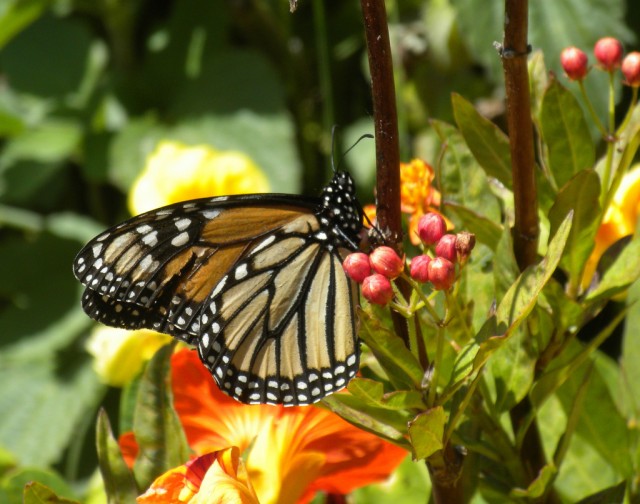
I’ve been blogging about monarch butterflies practically from the moment this blog began. I’ve been growing milkweed, the only host plant for monarch caterpillars, in our yard for over a decade—first in Crozet, Virginia, and then here in San Diego after our move seven years ago. When you leave a comment on this blog, if you don’t happen to have a WordPress avatar set up, the default avatar is a picture of milkweed from my garden. I made a very dopey video, once, showing some of our butterfly plants, and was lucky enough to catch a monarch in the act of laying an egg on the underside of a leaf. We’ve been a family wrapped up in bees and butterflies for a very long time.
We had a fair number of caterpillars last year, enough to eat our five plants to the ground. But this year may be different.
This year, the giant migration that takes place in the mountains of Mexico has been, well, not exactly giant.
…for the first time in memory, the monarch butterflies didn’t come, at least not on the Day of the Dead. They began to straggle in a week later than usual, in record-low numbers. Last year’s low of 60 million now seems great compared with the fewer than three million that have shown up so far this year. Some experts fear that the spectacular migration could be near collapse.
The reasons aren’t a mystery:
A big part of it is the way the United States farms. As the price of corn has soared in recent years, driven by federal subsidies for biofuels, farmers have expanded their fields. That has meant plowing every scrap of earth that can grow a corn plant, including millions of acres of land once reserved in a federal program for conservation purposes.
Another major cause is farming with Roundup, a herbicide that kills virtually all plants except crops that are genetically modified to survive it.
As a result, millions of acres of native plants, especially milkweed, an important source of nectar for many species, and vital for monarch butterfly larvae, have been wiped out. One study showed that Iowa has lost almost 60 percent of its milkweed, and another found 90 percent was gone. “The agricultural landscape has been sterilized,” said Dr. Brower.
This article touches, too, on the dire plight of the honeybee, about which I’ve had much to say on this blog over the years.
I don’t often feel helpless. But with this, I do. What can I do beyond the small acts I’ve been making? Planting milkweed, singing the joys of bee-and-butterfly gardening, avoiding pesticides and herbicides even though that means I have a weedy garden. Keep on singing, I guess?
Add a CommentBlog: Here in the Bonny Glen (Login to Add to MyJacketFlap)
JacketFlap tags: Nature Study, honeybees, Fruitless Fall, bee colony collapse, Current Affairs, bees, Add a tag
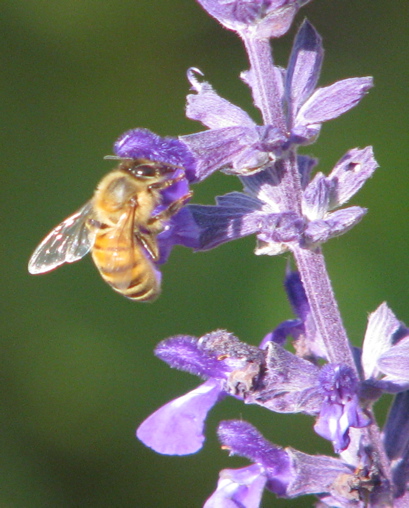
I know I’ve been singing this song for a long time, y’all, but it’s bad, bad, bad and getting worse.
Soaring Bee Deaths in 2012 Sound Alarm on Malady – NYTimes.com
“They looked so healthy last spring,” said Bill Dahle, 50, who owns Big Sky Honey in Fairview, Mont. “We were so proud of them. Then, about the first of September, they started to fall on their face, to die like crazy. We’ve been doing this 30 years, and we’ve never experienced this kind of loss before.”
When beekeepers and scientists first starting investigating colony collapse disorder, causes were uncertain. Rowan Jacobsen’s excellent book, Fruitless Fall, explores possible reasons. (Here’s one of my many posts about the book.)
Five years later, we have a much clearer idea of exactly what is happening, and it’s very bad news.
But many beekeepers suspect the biggest culprit is the growing soup of pesticides, fungicides and herbicides that are used to control pests.
While each substance has been certified, there has been less study of their combined effects. Nor, many critics say, have scientists sufficiently studied the impact of neonicotinoids, the nicotine-derived pesticide that European regulators implicate in bee deaths.
The explosive growth of neonicotinoids since 2005 has roughly tracked rising bee deaths.
Neonics, as farmers call them, are applied in smaller doses than older pesticides. They are systemic pesticides, often embedded in seeds so that the plant itself carries the chemical that kills insects that feed on it.
The pesticide is embedded in the seeds. I posted to another piece on this topic this last week, and these are just a couple of the many anxious reports I’ve picked up on my bee wire (Google Alerts, when they’re working) in the past few months. I know I’m probably preaching to the choir here, but I implore you to read up on this issue, if you haven’t yet, and to spread the word far and wide. If we lose the bees, we lose the world as we know it.
Add a CommentBlog: Here in the Bonny Glen (Login to Add to MyJacketFlap)
JacketFlap tags: Books, bees, Nature Study, Add a tag
View Next 25 Posts















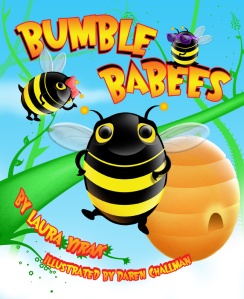
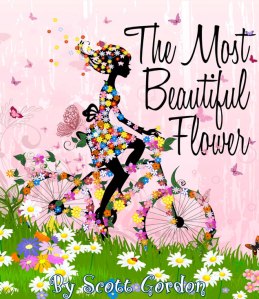

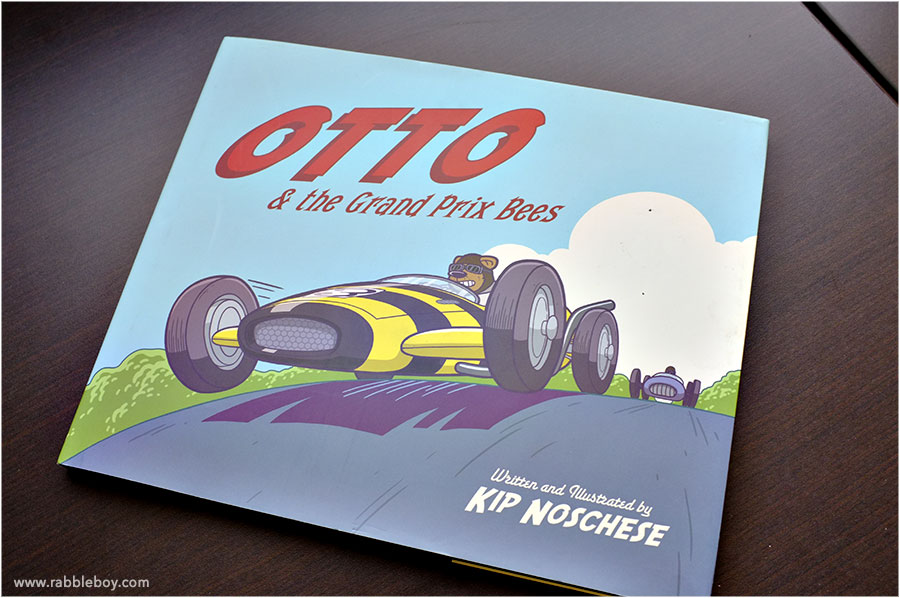
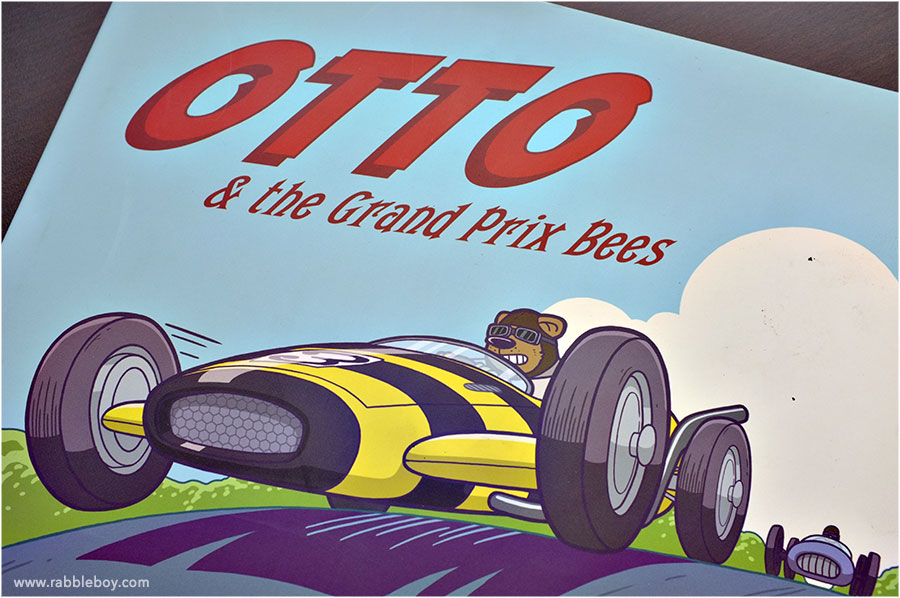
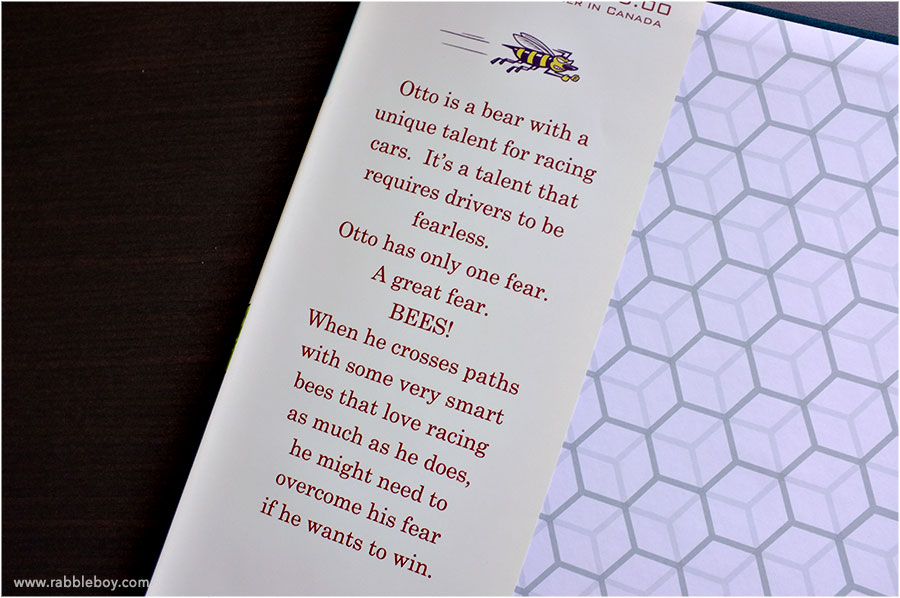
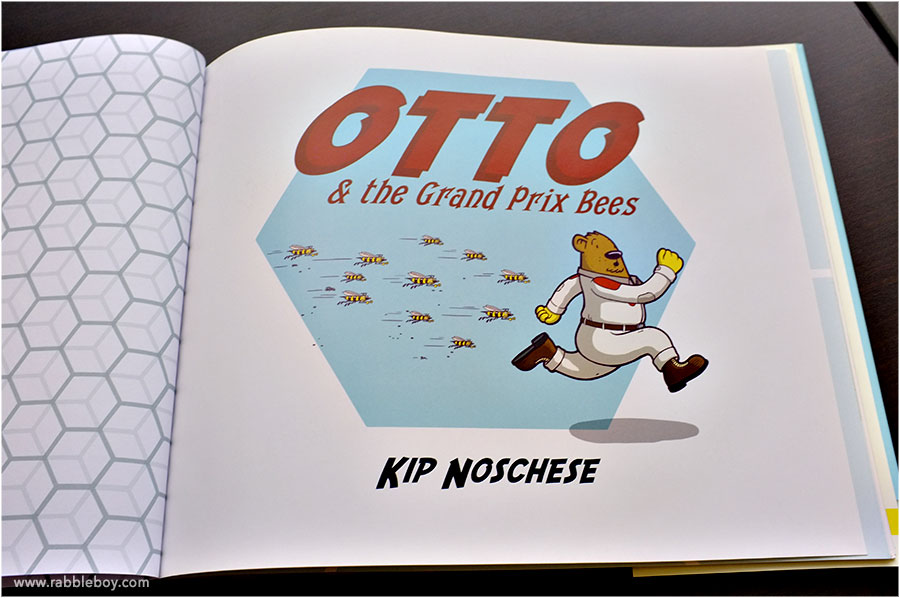
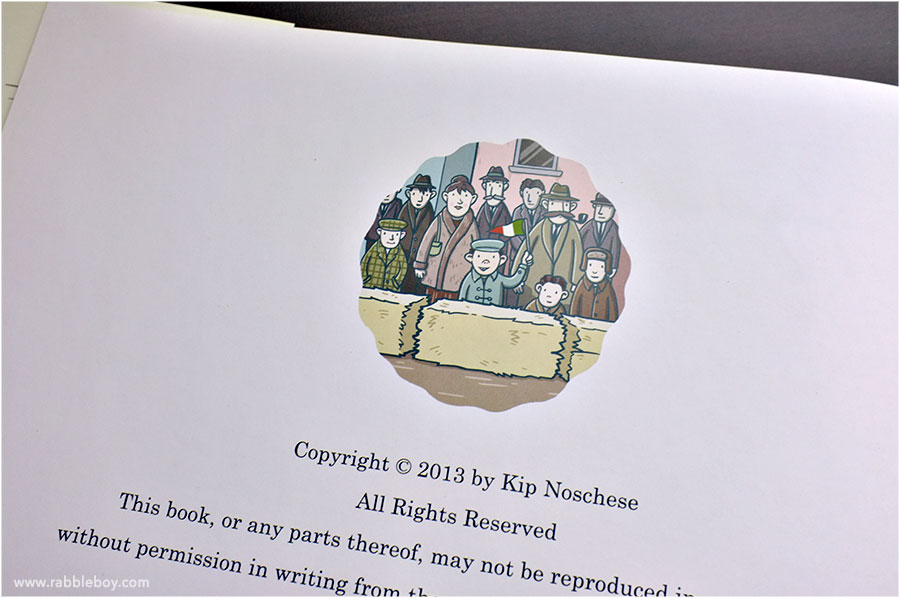
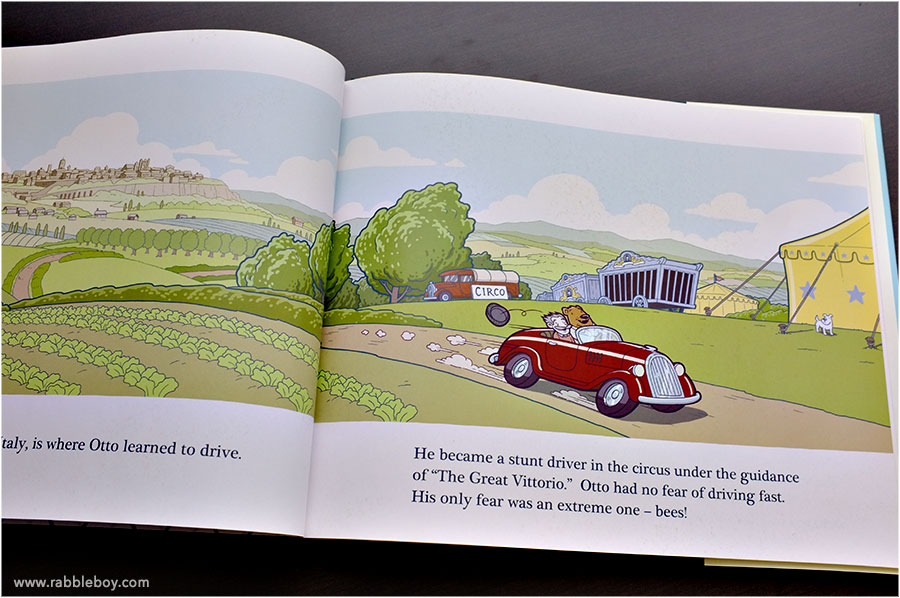
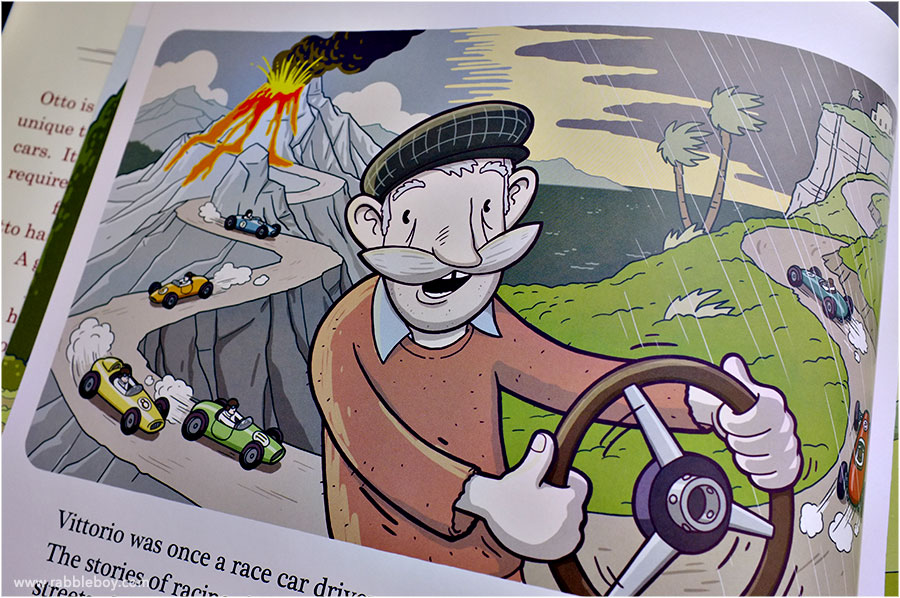
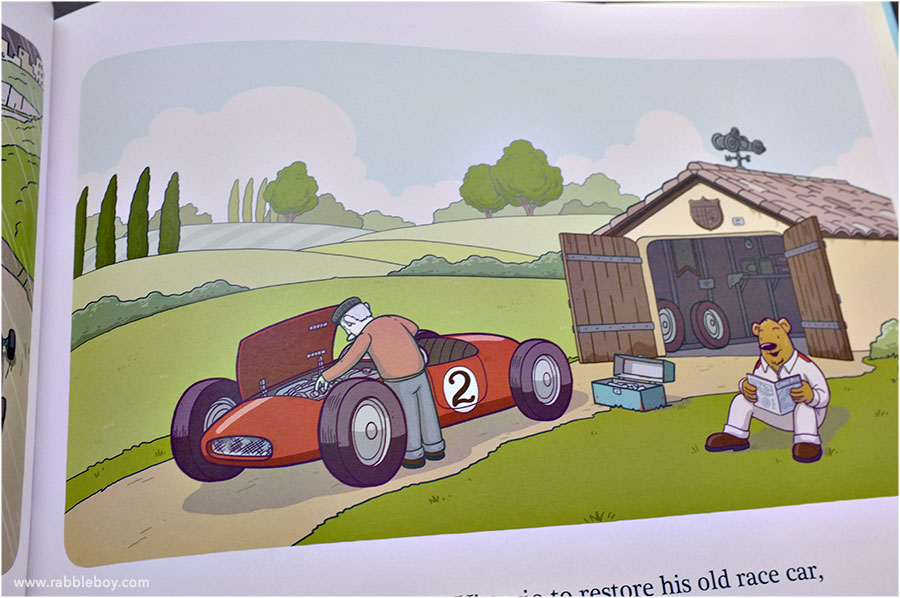
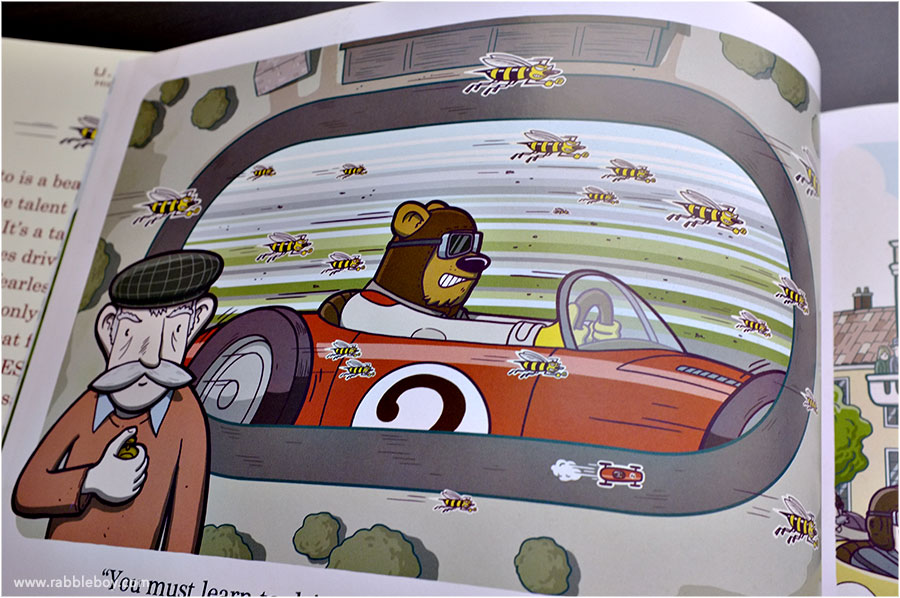
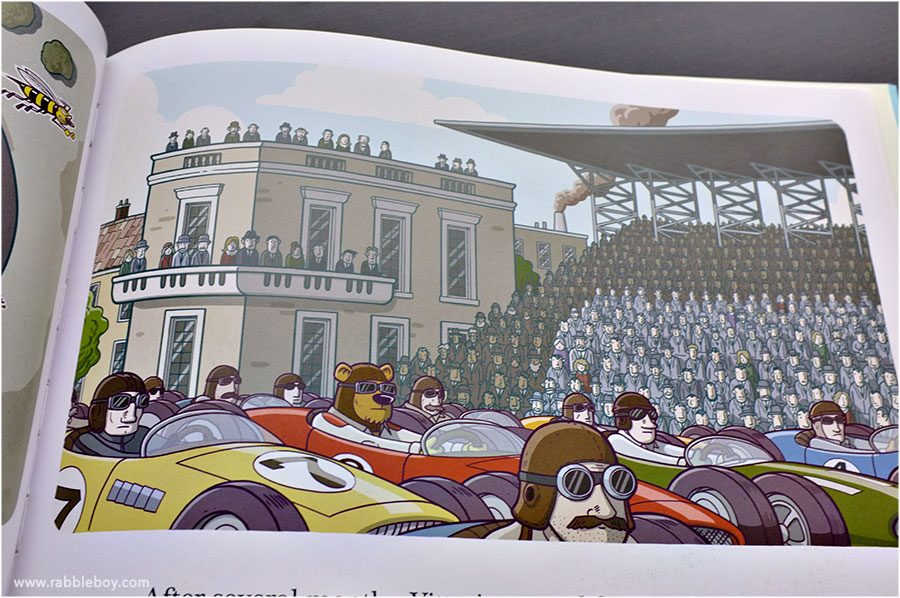
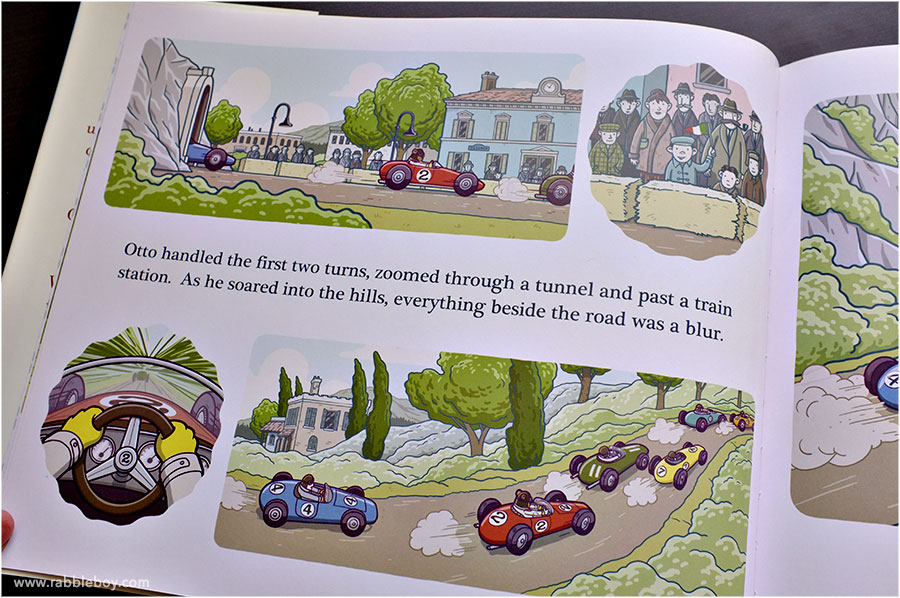
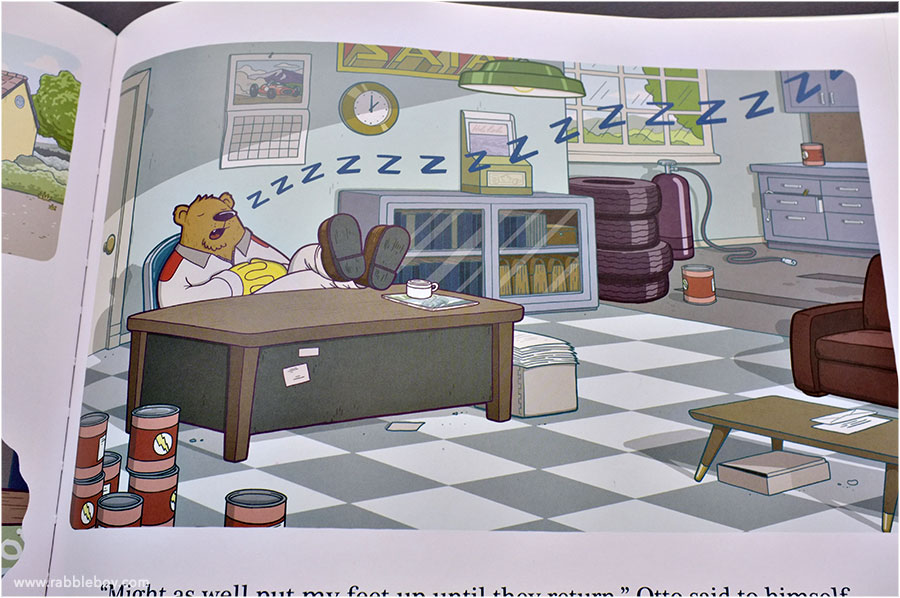
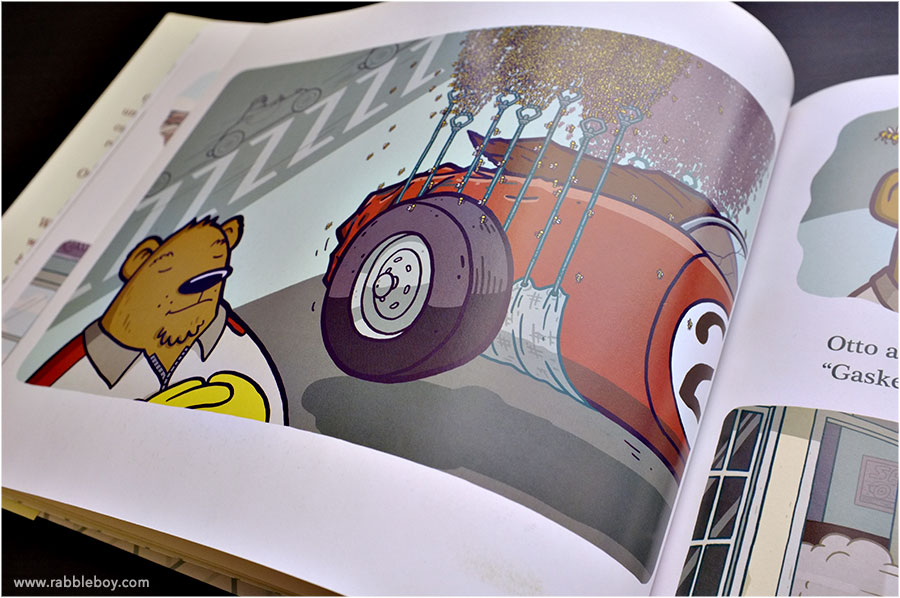
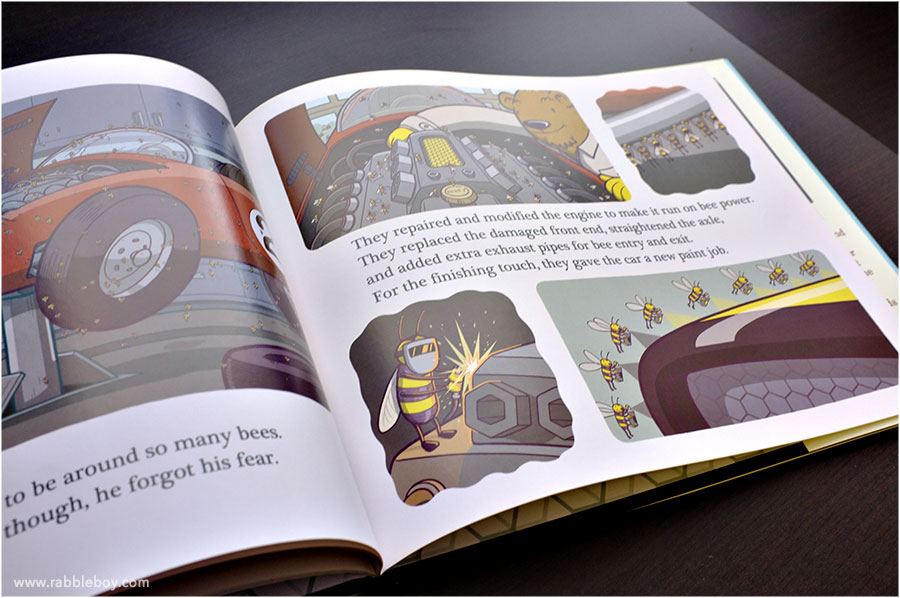
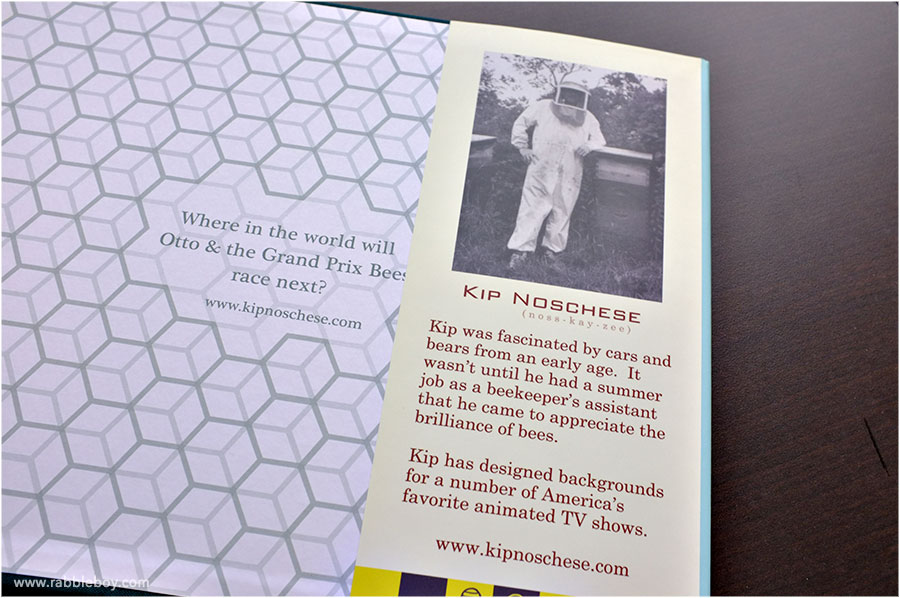
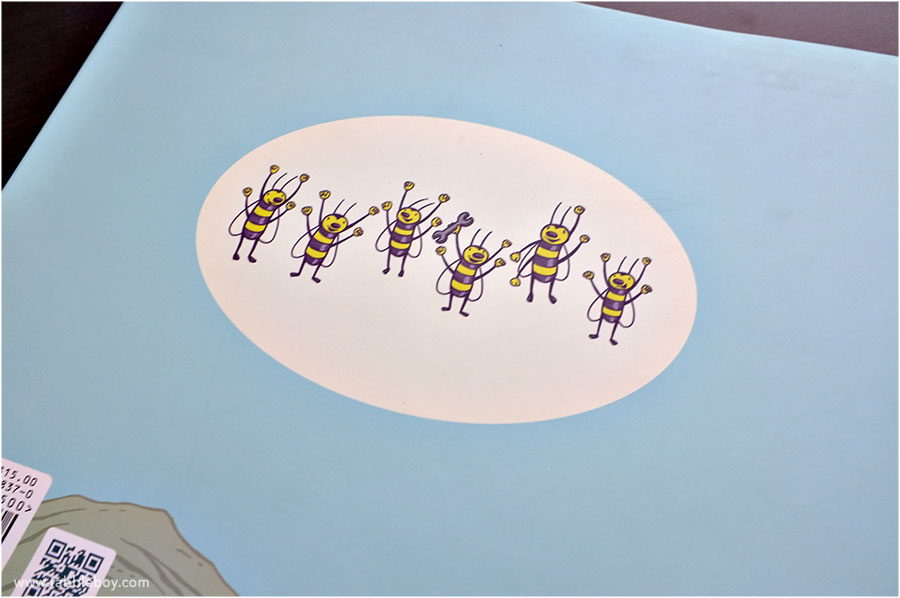


Zoe, this is a fabulous idea! Thank you for helping the bees